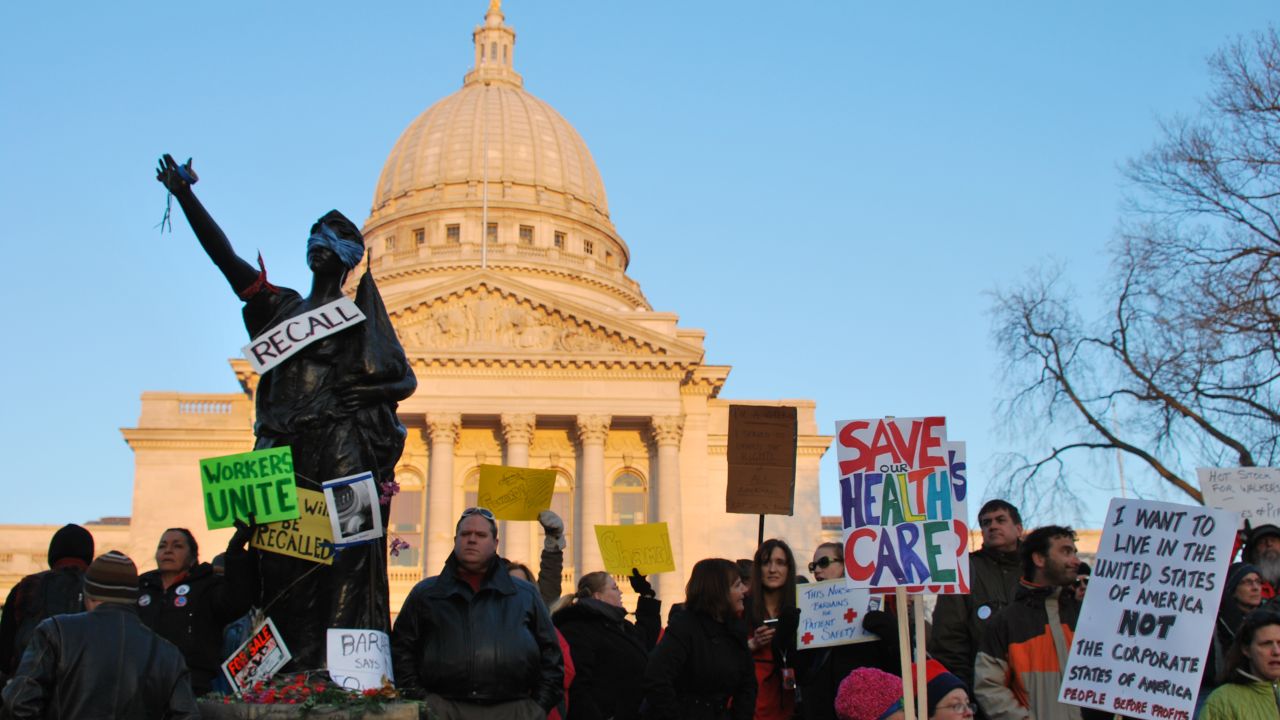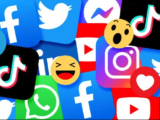Why the social-media honeymoon may be over for some activists.

Social media helped ignite protests like this one at Wisconsin’s state capitol, but the tools are becoming harder for insurgent groups to use effectively: Mira Oberman/AFP/Getty
By Sarah Jaffe –
Around the country, thousands have returned to the streets again to protest the deaths of black people at the hands of the police. One of those deaths, the shooting of 32-year-old Philando Castile in Falcon Heights, Minnesota, was broadcast on Facebook Live by Castile’s girlfriend, Diamond Reynolds, spurring the outrage that prompted people around the country to act.
The fact that an extraordinarily self-possessed user managed to deploy Facebook’s live tool to broadcast a police killing seemed inevitable once it had happened. Videos of other such killings, spread by social media, have been a key driver of the Black Lives Matter movement. While Facebook’s decision to privilege video, particularly video hosted on Facebook itself, in its ever-changing algorithms likely helped Reynolds’s video go viral, but also raises questions about how much power social networking sites have over politics and activism.
While social media has become integral to the work of political organizing, activists are victims of the success they’ve helped create for the social networks. As social networking companies become the new media giants, they’ve become less welcoming to the grass roots. Algorithm tweaks leave some scrambling to adapt their strategies. Harassment and trolling — particularly targeting the marginalized — drive others away. And then there is the question of whether progressive activists can trust the motives of those who control the media they use.
For activists, this presents challenges. As Malaya Davis of the Ohio Student Association notes, social media remains a particularly potent tool in “high-intensity movement moments” like now, as well as for community-building in quieter times. Yet problems emerging around the use of social media have led organizers like herself to examine their strategy.
Algorithm Troubles
Online organizing persists, despite the fact that Facebook sometimes seems determined to kill it. With some 1.65 billion active users, Facebook is easily the world’s largest social network, and that means that every tweak in the algorithms that decide which information its users will see can have a massive effect.
Jenni Dye, who first made her Twitter account public during the Wisconsin protests against Gov. Scott Walker’s 2011 anti-union law, considers that moment a “sweet spot in the emergence of social media.”
“More and more people were joining Twitter and Facebook, so it was the perfect opportunity to reach a bunch of people but not so many people that your message got drowned out,” she says. Now, as an elected member of the Dane County Board of Supervisors and the research director for the nonprofit One Wisconsin Now, she finds that on social media “we’ve reached a point where there are so many voices that it’s harder to break through that noise.” Even reaching people who have already “liked” her organization’s page has become a challenge.
“You have to have a lot of time to keep up with the algorithm,” she adds. “If you aren’t going to buy into their just-pay-to-have-your-content-seen service strategy, you have to have time then to come up with a strategy of how to work within the algorithm to still be seen.” That makes it harder for new voices and new organizations to break in, Dye notes. Groups or individual users who already have a lot of friends or likes will be more likely to show up in users’ news feed, generating even more clicks for them.
The recent changes in the site seem aimed at producing more revenue for Facebook; users who can’t afford to pay to promote their pages often find their content hidden with only a few lonely “Likes.” (Facebook did not respond to multiple requests for an interview for this piece.)
“Their pushing of sponsored content has become much more aggressive over the past six months or so,” says Cayden Mak, chief technology officer of 18 Million Rising, a group founded to promote civic engagement and movements within the Asian-American and Pacific Islander community. “It is really tempting, because they’re like, ‘For a very small amount of money you can promote your thing!’ and it’s in everything. When I look at Facebook on my phone during off hours it’s like ‘Don’t you want to promote 18 Million Rising?’” Other organizers complain of event invitations being limited in an attempt, perhaps, to push them toward paid advertising.
Of particular concern to political organizers lately has been the question of whether Facebook is intentionally stifling certain topics. The site launched a new tagging system in January to help organizations better target their desired audiences, but the news broke that Black Lives Matter was not an available tag in the system. That followed on the heels of a report, citing a former Facebook “news curator,” that the curators regularly suppressed conservative news, and led Facebook users once again to wonder how much control they had over their experience on the site. Facebook curators also said that they were told to “inject” selected stories into the site’s trending topics.
“It does raise the question of how much of this is human control,” Mak says. “It’s impossible to say where humans come into the process and who those humans are, what their perspectives, understandings and biases are.” Those perspectives can come into play with trending topic curation or even content moderation. “If you’re reporting content to content moderators in multiple countries who don’t necessarily understand, especially when we talk about the ways that we talk about race and racism in the US context, it opens up this door for basically naive censorship.” Posts that use certain words or imagery often get pulled, he explains, even if the words were used to describe something that happened rather than to insult, or an image had news or historical value. More questions arose when Diamond Reynolds’ video of the Castile shooting disappeared from Facebook. The company originally blamed its disappearance on a “glitch” but an unconfirmed report later surfaced blaming the police.
Because it’s not an arm of the government or a public utility, Facebook is under no First Amendment obligations. Under the company’s Terms of Service, it can block any content it wants, but its users would like some transparency in how those choices are made. Michelle Gunderson, a teacher and member of the Chicago Teachers Union and the Caucus of Rank-and-File Educators says that she’s been put in “Facebook jail” (had her account blocked from posting) after a post she wrote about the education reform group Teach for America was reported.
Even so, Gunderson and the CTU teachers continue to use Facebook and have found ways to work within its algorithms. They shot one-minute videos around their April strike vote, explaining their reasons for voting to walk off the job, which were particularly successful.
Facebook has been central to the work of OUR Walmart, a group of Walmart workers who have been organizing for better working conditions at the retail giant since 2012. But they spend less time these days on their main page, using a small bit of paid promotion as a supplement to it. Unlike most of the labor movement, which still uses social mainly to push one-way messages, OUR Walmart uses Facebook groups to connect to new recruits and let workers connect with each other and realize the problems that are common across multiple stores. On the Facebook groups, “people find other people in their stores,” says Cynthia Murray, one of the group’s founding members. “They had no idea that they were in one of our groups.”
Social media, says Andrea Dehlendorf, co-director of OUR Walmart, is “such an opportunity for workers to build power for themselves, and it requires organizations to be really open and to not fear the dialogue.” The workers, not staff members, are the most effective organizers.
Ultimately, whether it makes sense for organizers to spend a lot of energy (or money) on Facebook depends on which audience they are trying to reach. Social media was an effective part of the Ohio Student Association’s successful campaign against Cuyahoga County Prosector Timothy McGinty after the failure to prosecute the police officer who killed 12-year-old Tamir Rice and the botched prosecutions of other officers who killed black Cleveland residents.
“Most of the stuff that we produce online is for a specific audience, typically young people, mostly young people of color who are interested in racial and economic justice but there are also older folks who follow us on social media,” says OSU’s Davis. She says people under 25 are using Facebook less and spending more time on Twitter. But Twitter comes with its own set of problems.
Twitter Strife
Twitter has a troll problem. This is not news to the company; its CEO admitted in 2015, “We suck at dealing with abuse.” Twitter rolled out the beginnings of a new plan for dealing with the harassment that many of its users face this year, but that hasn’t stopped many of the people I spoke with for this story cutting back on their use of the site.
“It feels like the fun, the joy of Twitter has been sucked out,” says Dye. In part, she notes, that’s because more journalists are actually using Twitter to report news, and there’s also been a flood of corporate accounts using Twitter for brand-building. “On the other hand,” she notes, “there is also a rise in everyday users and that has resulted in a rise of the same culture that we see everywhere on the internet, whether it’s Twitter or Facebook or the comments section in your local newspaper. People say horrible things on the internet that they would never say in person.”
The British think tank Demos (not to be confused with the US-based organization by the same name) ran a study mapping thousands of tweets and “found 6,500 unique users were targeted by 10,000 explicitly aggressive and misogynistic tweets.” They filtered tweets to attempt to avoid the kind of “naive censorship” Mak mentions, attempting to identify which tweets were genuinely abusive. They also noted that despite the study focusing specifically on misogynist abuse, 50 percent of the propagators of such tweets were women. Abuse, Mak notes, is certainly not specific to Twitter and certain other platforms, like Tumblr, “but it is endemic to those platforms.”
Even aside from the question of trolls, Twitter has just become more work. Gunderson and her teachers’ union colleagues have begun spending more time attending events and public meetings and live-tweeting them.
Because journalists rely on Twitter during “movement moments,” Davis says there’s a tendency for the media to anoint movement “leaders” based on their Twitter presence, which doesn’t always reflect their actual status. She also noted the recent decision of the Dream Defenders, an organization of young people of color that grew out of the protests after the death of Trayvon Martin, to have a “social media blackout” to reconsider the role of social media in their work.
“I do not mean to send the message that the internet is not a powerful tool for our movement or that digital organizing doesn’t matter,” wrote Dream Defenders Chief of Strategy Rachel Gilmer on the organization’s blog after the blackout. “However, we must recognize that the internet in and of itself is not a democratizing force and should not replace community-owned media outlets. As much as we would like to believe otherwise, the purpose of social media is to collect data and sell advertising space to corporations so we buy their stuff and build their power.”
Whose Media? Our Media
The importance of controlling the media you use is not lost on any of the organizers. OUR Walmart is working on building its own platform for just that reason. Social media has allowed the independent nonprofit to function on a shoestring budget, particularly after the United Food and Commercial Workers union, which had backed the organization, cut its funding in 2015. So now the group is thinking of making its own.
The goal is to create a platform that belongs to the workers, not to a massive corporation. “What we’re trying to figure out is how do you add a new space online that is really devoted to workers helping each other,” says Dehlendorf. “Workers themselves have a tremendous amount of accumulated knowledge and skill and experience if we’re just able to use technology to connect them to the people who have big needs.”
OUR Walmart is building an app that would allow for Walmart workers not only to organize but to connect to a group of “peer advisers” who can answer questions about Walmart policy and legal rights, and propose ways to handle problems. If the app works, Dehlendorf says her group will make it available to other worker organizations.
For now, however, Facebook and Twitter are the dominant social media and potential drivers of political behavior. In 2014, a Pew study found that 16 percent of registered voters followed candidates or other political figures on social media and voters who use social media were more likely to volunteer for a campaign or candidate. In a January 2016 Pew survey 14 percent of respondents said they found social media “most helpful” in learning about the election, a figure that more than doubled, to 35 percent, for those 18-29. Facebook was by far the most common site for getting election-related information.
This year, days before the deadline, Facebook sent a May 16 reminder to Californians to register to vote. It prompted the second-highest online registration activity in the site’s four-year history, according to California Secretary of State Alex Padilla.
As Micah Sifry wrote in 2014, Facebook has experimented with the effectiveness of such tools for increasing voter turnout — one experiment tweaked the feeds of 1.9 million users to contain more hard-news stories, and its researchers claimed a measurable increase in voter turnout thanks to its actions. But, Sifry noted, if the company is not going to be transparent about its experiments, such power is cause for concern rather than celebration. “Using those tools, national political campaigns, building on the Obama 2012 reelection effort, are learning how to ‘engineer the public’ without the public’s knowledge, as sociologist Zeynep Tufekci has warned,” Sifry wrote.
Facebook’s new tools for electioneering are likely to make the company big bucks from the major presidential candidates and high-profile congressional races. But for local candidates, it’s a very different story. “For Hillary Clinton, Facebook targeting is definitely going to work for her campaign. If you’re running for governor, Facebook targeting is going to work for your campaign,” says Jenni Dye. “Even if you’re running for a state senate seat, you’re probably going to be able to utilize Facebook targeting.” On the Dane County Board of Supervisors, “my district is part of a ZIP code,” she says. “I don’t have all of my city, so how do I target it down to those people at a price point that is reasonable for somebody who is running a local election?”
In 2011, she says, social media was much more helpful, but now, its emphasis on pay-for-play services combined with the imprecision of its tools at the hyper-local level means it’s much less useful for her. And because campaigns like hers are unlikely to have lots of money to spend, Facebook has little incentive to develop targeting that will work for people like Dye. Instead, she finds herself using email to ask people to share a post on Facebook. “I have to actually purposefully activate my network to activate theirs. It’s like the Facebook version of a phone tree,” she says.
Social media may, as Cayden Mak notes, be closer and closer to simply becoming mainstream media these days, but that makes it paradoxically harder for organizers to avoid. The past week’s uprisings around the country have underscored how important it is. “I don’t know what the next 10 years looks like for traditional organizing but I know that social media is definitely going to be taking a larger role in it than what we are even experiencing now,” Davis says. “It’s in our best interests to figure out how do we move this to the best of our ability to build the power that we need.”
—
Republished from the Website BillMoyers.com
Sarah Jaffe is a reporting fellow at The Nation Institute and the co-host of Dissent magazine’s Belabored podcast. Her book, Necessary Trouble: America’s New Radicals, is due out from Nation Books in August 2016.













